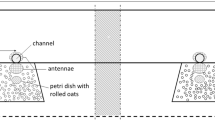Abstract
Two series of cafeteria tests involving six varieties of Trifolium repens were conducted to confirm the preference of fossorial Arvicola terrestris for acyanogenic white clover (T. repens) and to investigate their responses to repeated exposures to toxic plants. The animals were offered the choice between two bunches of freshly harvested white clover. In 261 simple choice tests, 160 individuals were tested for various combinations of three acyanogenic and three cyanogenic varieties. They showed a clear preference for the acyanogenic morphs, both in comparisons between opposite cyanotypes and in two control situations involving either self-comparisons or comparisons between similar cyanotypes. In 320 repeated choice tests, 40 voles assigned to three groups (comparisons between opposite cyanotypes and control comparisons between similar cyanotypes) were tested eight times for the same alternative. They showed a persistent preference for the acyanogenic morph and significantly reduced their total food consumption when they had a strictly cyanogenic diet. In the latter case, they stored or wasted more plant material than in the other treatments. These voles also ingested high amounts of cyanide which suggests good detoxification abilities and a possible habituation to cyanide.
Similar content being viewed by others
REFERENCES
Caradus,Ñ J.ÑR.Ñ1986.ÑWorldÑchecklistÑofÑwhiteÑcloverÑvarieties.ÑN.Z.ÑJ.ÑExp.ÑAgric.Ñ14:119–164.
Caradus,Ñ J.ÑR.,Ñ Mackay,Ñ A.ÑC.,Ñ Woodfield,Ñ D.ÑR.,Ñ Van,Ñ D.ÑB.ÑJ.,ÑandÑ Wewala,Ñ S.Ñ1989.ÑClassificationÑofÑaÑworldÑcollectionÑofÑwhiteÑcloverÑcultivars.ÑEuphyticaÑ42:183–196.
Crush,Ñ J.ÑR.,ÑandÑ Caradus,Ñ J.ÑR.Ñ1995.ÑCyanogenesisÑpotentialÑandÑiodineÑconcentrationÑinÑwhiteÑcloverÑ(TrifoliumÑrepensÑL.)Ñcultivars.ÑN.Z.ÑJ.ÑAgric.ÑRes.Ñ38:309–316.
Freeland,Ñ W.ÑJ.,ÑandÑ Janzen,Ñ D.ÑH.Ñ1974.ÑStrategyÑinÑherbivoryÑbyÑmammals:ÑTheÑroleÑofÑplantÑsecondaryÑcompounds.ÑAm.ÑNat.Ñ108:269–289.
Gutzwiller,Ñ A.Ñ1993.ÑTheÑeffectÑofÑaÑdietÑcontainingÑcyanogenicÑglycosidesÑonÑtheÑseleniumÑstatusÑandÑtheÑthyroidÑfunctionÑofÑsheep.ÑAnim.ÑProd.Ñ57:415–419.
Heath,Ñ D.Ñ1995.ÑAnÑIntroductionÑtoÑExperimentalÑDesignÑandÑStatisticsÑforÑBiology.ÑUCLÑPress,Ñ London.
Hendry,Ñ G.ÑA.ÑF.,ÑandÑ Grime,Ñ J.ÑP.Ñ1993.ÑMethodsÑinÑComparativeÑPlantÑEcology.ÑAÑLaboratoryÑManual.ÑChapmanÑ&ÑHall,Ñ London.
Hruska,Ñ A.ÑJ.Ñ1988.ÑCyanogenicÑglucosidesÑasÑdefenseÑcompounds.ÑAÑreviewÑofÑtheÑevidence.ÑJ.ÑChem.ÑEcol.Ñ14:2213–2217.
Hughes,Ñ M.ÑA.Ñ1970.ÑCyanogenesisÑinÑwhiteÑclover,Ñpp.Ñ123–131,ÑinÑJ.ÑD.Ñ LoweÑ(ed.).ÑWhiteÑCloverÑResearchÑOccasionalÑSymposium.ÑNo.Ñ6.ÑBritishÑGrasslandÑSociety.
Hughes,Ñ M.ÑA.Ñ1981.ÑTheÑgeneticÑcontrolÑofÑplantÑcyanogenesis,Ñpp.Ñ494–508,ÑinÑB.Ñ Vennesland,Ñ C.ÑJ.Ñ Knowles,Ñ E.ÑE.Ñ Conn,Ñ J.Ñ Westley,ÑandÑ J.Ñ WissingÑ(eds.).ÑCyanideÑinÑBiology.ÑAcademicÑPress,Ñ London.
Hurlbert,Ñ S.ÑH.Ñ1984.ÑPseudoreplicationÑandÑtheÑdesignÑofÑecologicalÑfieldÑexperiments.ÑEcol.ÑMonogr.Ñ54:187–211.
Jones,Ñ D.ÑA.Ñ1972.ÑCyanogenicÑglycosidesÑandÑtheirÑfunction,Ñpp.Ñ103–124,ÑinÑJ.ÑB.Ñ HarborneÑ(ed.).ÑPhytochemicalÑEcology.ÑAcademicÑPress,Ñ London.
Jones,Ñ D.ÑA.Ñ1988.ÑCyanogenesisÑinÑanimal-plantÑinteractions,Ñpp.Ñ151–170,ÑinÑD.Ñ EveredÑandÑ S.Ñ HarnettÑ(eds.).ÑCyanideÑCompoundsÑinÑBiology.ÑJohnÑWileyÑ&ÑSons,Ñ Chichester.
Jones,Ñ D.ÑA.Ñ1998.ÑWhyÑareÑsoÑmanyÑfoodÑplantsÑcyanogenic?ÑPhytochemistryÑ47:155–162.
Lehmann,Ñ J.,Ñ Meister,Ñ E.,Ñ Gutzwiller,Ñ A.,Ñ Jans,Ñ F.,Ñ Charles,Ñ J.-P.,ÑandÑ Blum,Ñ J.Ñ1991.ÑPeut-onÑutiliserÑdesÑvariétésÑdeÑtrèfleÑblancÑ(TrifoliumÑrepensÑL.)ÑàÑforteÑteneurÑenÑacideÑcyanhydrique?ÑRev.ÑSuisseÑAgric.Ñ23:107–112.
Łomnicki,Ñ A.Ñ1974.ÑEvolutionÑofÑtheÑherbivore-plant,Ñpredator-prey,ÑandÑparasite-hostÑsystems:ÑAÑtheoreticalÑmodel.ÑAm.ÑNat.Ñ108:167–180.
Łomnicki,Ñ A.Ñ1976.ÑEvolutionÑofÑplantÑresistanceÑandÑherbivoreÑpopulationÑcycles.ÑAm.ÑNat.Ñ110:198–200.
Nahrstedt,Ñ A.,Ñ Erb,Ñ N.,ÑandÑ Zinsmeister,Ñ H.-D.Ñ1981.ÑMethodsÑofÑliberatingÑandÑestimatingÑhydrocyanicÑacidÑfromÑcyanogenicÑmaterial,Ñpp.Ñ460–471,ÑinÑB.Ñ Vennesland,Ñ C.ÑJ.Ñ Knowles,Ñ E.ÑE. Conn,Ñ J.Ñ Westley,ÑandÑ J.Ñ WissingÑ(eds.).ÑCyanideÑinÑBiology.ÑAcademicÑPress,Ñ London.
OECD.Ñ1993.ÑOECDÑSchemesÑforÑtheÑVarietalÑCertificationÑofÑSeedÑMovingÑinÑInternationalÑTrade:ÑListÑofÑCultivarsÑEligibleÑforÑCertification.ÑOECDÑ184,Ñ Paris.
Saucy,Ñ F.,Ñ Studer,Ñ J.,Ñ Schneiter,Ñ B.,ÑandÑ Aerni,Ñ V.Ñ1999.ÑPreferencesÑforÑacyanogenicÑwhiteÑcloverÑ(TrifoliumÑrepens)ÑinÑtheÑvoleÑArvicolaÑterrestris.ÑI.ÑPreliminaryÑresultsÑwithÑtwoÑvarietiesÑ(LadinoÑandÑAran)ÑandÑcomplementaryÑtestsÑwithÑtheÑslugsÑArionÑaterÑandÑA.Ñsubfuscus.ÑJ.ÑChem.ÑEcol.Ñ25:1441–1454.
SEIGLER,Ñ D.ÑS.Ñ1991.ÑCyanideÑandÑcyanogenicÑglycosides,Ñpp.Ñ35–77,ÑinÑG.ÑA.Ñ RosenthalÑandÑ M.ÑR.Ñ BerenbaumÑ(eds.).ÑHerbivores:ÑTheirÑInteractionsÑwithÑSecondaryÑPlantÑMetabolites.ÑAcademicÑPress,Ñ SanÑDiego.
Sokal,Ñ R.ÑR.,ÑandÑ Rohlf,Ñ F.ÑJ.Ñ1995.ÑBiometry.ÑW.ÑH.ÑFreemanÑandÑCompany,Ñ NewÑYork.
Stochmal,Ñ A.,ÑandÑ Oleszek,Ñ W.Ñ1997.ÑChangesÑofÑcyanogenicÑglucosidesÑinÑwhiteÑcloverÑ(TrifoliumÑrepensÑL.)ÑduringÑtheÑgrowingÑseason.ÑJ.ÑAgric.ÑFoodÑChem.Ñ45:4333–4336.
Till-Bottraud,Ñ I.,ÑandÑ Gouyon,Ñ P.ÑH.Ñ1992.ÑIntraplantÑversusÑinterplantÑBatesianÑmimicry?ÑAÑmodelÑonÑcyanogenesisÑandÑherbivoryÑinÑclonalÑplants.ÑAm.ÑNat.Ñ139:509–520.
Author information
Authors and Affiliations
Rights and permissions
About this article
Cite this article
Viette, M., Tettamanti, C. & Saucy, F. Preference for Acyanogenic White Clover (Trifolium Repens) in the Vole Arvicola Terrestris. II. Generalization and Further Investigations. J Chem Ecol 26, 101–122 (2000). https://doi.org/10.1023/A:1005441528235
Issue Date:
DOI: https://doi.org/10.1023/A:1005441528235




